Zündapp
This articleneeds additional citations forverification.(September 2018) |
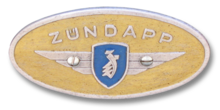 | |
| Industry | Machine tools,motor vehicles |
|---|---|
| Founded | 1917 |
| Defunct | 1984 |
| Headquarters | Germany |
| Products | Detonators,motorcycles,microcars,sewing machines,mopeds |
Zündapp(a.k.a. Zuendapp) was a major Germanmotorcyclemanufacturer founded in 1917 inNurembergby Fritz Neumeyer, together with the FriedrichKruppAG and themachine toolmanufacturer Thiel under the name "Zünder- undApparatebau G.m.b.H. "as a producer ofdetonators(Zünder- und Apparatebau is German for Igniter and Apparatus). In 1919, as the demand for weapons parts declined after World War I, Neumeyer became the sole proprietor of the company, and two years later he diversified into the construction of motorcycles.
Following World War II, Zündapp expanded into themicrocar,mopedandscootermarkets. The company collapsed in 1984.
Early history: 1919–45[edit]
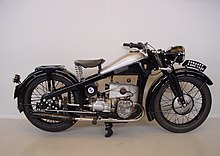




The first Zündapp motorcycle was the modelZ22in 1921. This was theMotorrad für Jedermann( "motorcycle for everyone" ), a simple, reliable design that was produced in large series. Zündapp's history of heavy motorcycles began in 1933 with the K-series. The "K" refers to the type of drivetrain that these models used,Kardanantrieb,meaning encloseddriveshaftwith twouniversal joints.Zündapp introduced the enclosedcrankcase(then a novelty). The series encompassed models from 200 to 800 ccdisplacementand was a major success, increasing Zündapp's market share in Germany from 5% in 1931 to 18% in 1937.
TheZündapp KS600,first released in 1938, had a 28 hp (21 kW) horizontally opposed twin cylinder motor with overhead valves displacing 597 cc (36.4 cu in). The KS600 was often coupled with a Steib sidecar, the BW38 (Beiwagen1938). The BW38, fitted with the B1 (Boot no. 1) sidecar body was produced between 1938 and 1941 and supplied exclusively to theWehrmacht.While the KS600 was discontinued and eventually replaced by the purpose-built KS750, its motor was to be the only remnant to live beyond the destruction of war. When Zündapp returned to motorcycle production in the late 1940s, it chose to reuse the KS600's motor to power the KS601 with few modifications.
The Zündapp K800 hadunit construction,flat-four engines with shaft drive (a layout adopted by Honda for theGold Wingin 1974) and were the only 4-cylinder machines used by the German armed forces in World War II.[1]
From 1931Ferdinand Porscheand Zündapp developed thetype 12 prototypeAuto für Jedermann( "car for everyone" ), which was the first time the nameVolkswagenwas used. Porsche preferred the 4-cylinder flat engine, but Zündapp used a water-cooled 5-cylinderradial engine.In 1932 three prototypes were running. All three cars were lost during the war, the last in a 1945Stuttgartbombing raid.
From 1936 to 1938 Zündapp produced the KKS500 model. This was the first Zündapp with a foot gear change, and 170 examples were built.[2]From 1940 onward Zündapp produced more than 18,000 units of theZündapp KS 750.[3]This is asidecaroutfit with a driven side wheel and alocking differential,supplied to the German Wehrmacht.
Zündapp also made aircraft engines including the9-092,which was used in light aircraft, including theBraunschweig LF-1 Zaunkönig(1942)ab initiotrainer aircraft.
Postwar: 1945–1984[edit]
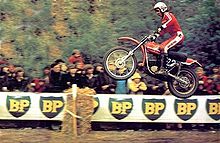
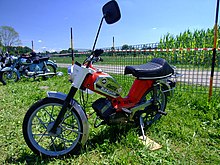

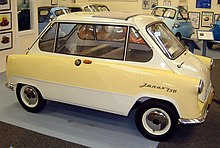

After World War II the company transitioned to smaller machines, notably the "Bella"motor scooter,which was a relatively heavy machine for its type. In 1951 Zündapp released the last of its heavy motorcycle models, but one of its most famous: the KS601 (the "green elephant" ) with a 598 cc two-cylinder engine. From 1957 to 1958 the company also produced theZündapp Janusmicrocar.[4]
In 1958 the company moved from Nuremberg toMunich.Subsequently, the company developed several new smaller models, discontinued the development offour-strokeengines and only producedtwo-strokemodels. Zündapp experienced enormous success in off-road motorsports winning thousands of Gold-Silver and bronze medals, many Championships. The American riderDave Ekinswon an overall victory at the 1967 Greenhorn Enduro aboard a 100cc Zündapp, defeating competitors on much larger motorcycles.[5]Belgian riderAndré Malherberode a Zündapp to win the 125cc Europeanmotocrosschampionships in 1973 and again in 1974.[6][7]Initially, Zündapp scooters and mopeds sold well, but later sales declined and in 1984 the company went bankrupt and closed. New legislation had destroyed the market for Zündapps high-speed 50 cc "Kleinkrafträder": to reduce noise and to reduce the accidents especially young riders had on those bikes, the new "80 cc" class was introduced. That made it much easier especially for the Japanese manufacturers to break into the previously protected market as they could easily downsize the 125 cc engines.Kreidlershared Zündapp's fate and went insolvent in 1982.
Post bankruptcy[edit]
After the bankruptcy, the entire production line and intellectual properties were bought by Xunda Motor Co.,Tianjin,China. They produced small Zündapp motorcycles from 1987 until the early 1990s. Zündapp later produced Honda-based four-stroke motorcycles and electric mopeds in the 2010s.[8]
Zündapp also had a technical collaboration withRoyal Enfield (India)to build mopeds and motorcycles. A dedicated factory was built at Ranipet near Madras (nowChennai) in the early 1980s to manufacture small, lightweight two-stroke motorcycles to be offered along with their flagshipRoyal Enfield Bullet.Enfield launched two 50 cc motorcycles first, the step-thruSilver Plusand the three-speed Explorer motorcycle. Later,Enfield Fury 175(based on Zündapp KS175) was introduced as a performance motorcycle. It had five-speed gearbox, a hydraulicBrembodisc brake and a sleeveless hard chromed cylinder barrel, all were a first on a motorcycle in that country. That being said, sales of these models were very low in the country.
In 2017, the Zündapp name returned to German hands after being purchased by Dieter Neumeyer, the grandson of company founder Fritz Neumeyer. The newly owned company subsequently producede-bicyclesand later revealed a new motorcycle concept, the ZXA 500 Adventure, at the 2022Intermot ShowinCologne.[9]
Notes[edit]
- ^"1938 Zundapp K800 - Barber's Best".Motorcycle Classics.Ogden Publications. 7 November 2012.Archivedfrom the original on 24 December 2013.Retrieved23 December2013.
The Zundapp K800 is listed as one of the top 100 machines of the 20th century.
- ^Greg Williams (July–August 2009)."1937 Zundapp KKS500".Motorcycle Classics.Archivedfrom the original on 2009-06-24.Retrieved2009-08-04.
- ^Margie Siegal (July–August 2007)."1942 Zundapp KS750".Motorcycle Classics.Archivedfrom the original on 2010-08-30.Retrieved2009-08-11.
- ^Roberts, Andrew (20 November 2011)."Classic Zundapp Janus".The Telegraph.Archivedfrom the original on 31 January 2014.Retrieved23 December2013.
The Janus was envisaged as a 'quality bubble car' and Jim Hacking, a microcar expert and proud Zundapp owner, bristles with annoyance at the 2008 Time magazine article claiming that the Zundapp was one of the 50 worst cars of all time.
- ^"Greenhorn Enduro Winners".district37ama.org.Archivedfrom the original on 8 November 2016.Retrieved22 February2017.
- ^"1973 125cc European motocrosschampionship final standings".memotocross.fr.Archivedfrom the original on 5 March 2016.Retrieved3 February2016.
- ^"1974 125 cc European motocross championship final standings".memotocross.fr.Archivedfrom the original on 5 March 2016.Retrieved3 February2016.
- ^Xunda Motor Co. Ltd.Archived2011-01-12 at theWayback Machineretrieved 12 Dec. 2010
- ^Barstow, Ollie (12 October 2022)."From Germany to China and back [via Lidl] | Zundapp returns with ZXA 500 ADV".Visordown.Retrieved26 February2024.
References[edit]
- Reiner Scharfenberg, Günter Sengfelder, Siegfried Rauch:Zündapp im Bild.
- Band 1:Die Nürnberger Jahre 1922–1958.Motorbuch-Verlag, Stuttgart 1998,ISBN3-613-01919-1.
- Band 2:Die Münchener Jahre 1953–1984.Motorbuch-Verlag, Stuttgart 2000,ISBN3-613-02034-3.
- Siegfried Rauch, Johann Kleine Vennekate (Hrsg.):Zündapp.NeuauflageZündapp: 60 Jahre Zündapp-Technik.Kleine Vennekate, Lemgo 1996.
- Thomas Reinwald:Nürnberger Motorradindustrie.Podszun, Brilon 2002,ISBN3-86133-299-X.
- Frank O. Hrachowy:Kleinkrafträder in Deutschland – die ungedrosselten 50er der Klasse 4.Kleine Vennekate, Lemgo 2006,ISBN3-935517-26-2.
- Uwe Frensel:Zündapp Modellgeschichte von 1952–1984. Ein Leitfaden für Sammler.Heel, Königswinter 2009,ISBN978-3-89880-504-9.
External links[edit]
- Vehicle manufacturing companies established in 1917
- Vehicle manufacturing companies disestablished in 1984
- Moped manufacturers
- Motorcycle manufacturers of Germany
- Motorcycle trials
- Scooter manufacturers
- Sidecars
- German brands
- Defunct motor vehicle manufacturers of Germany
- Manufacturing companies based in Munich
- Manufacturing companies based in Nuremberg
- Military motorcycles
- Zündapp
